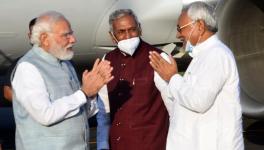When Mainstream Media Fails, Citizen Journalists Take Over

While it took three to four days for people across the country to find out about the brazen act of mass molestation at Gargi College on 6 February, news of the police brutality at Jamia Millia Islamia on 15 December 2019 and the raid by goons on the campus of Jawaharlal Nehru University on 5 January flashed all over the world within minutes.
The delay in reporting the Gargi College incident, in this era of information explosion, needs to be studied because all three institutions are located in Delhi, where most prominent news channels and news dailies have their head offices. Not only that, there would scarcely be a regional news outlet in the country that does not have at least a stringer in the Capital.
The failure of the media to highlight the Gargi incident raises questions over news-gathering in the country. As the large-scale attack by ruffians took place on the evening of the 8 February Assembly election, the media, especially electronic channels, were perhaps busy focusing their attention only on politics. Or, maybe, some media outlets thought it fit to practice self-censorship as the ‘goonda-gardi’ may have further politically damaged only one political outfit. The reason is simple: some of the hoodlums were heard raising the slogan of “Jai Shri Ram”, or Glory to Lord Ram, which is now a very popular Hindu Right political slogan.
Indeed, the college authorities’ response to the incident gives credence to ideas that they wanted to avoid tackling the crime straight-up.
In Jamia and JNU the students––especially of Mass Communications in the case of the former––started working as citizen journalists. It is they who, using their mobile phones, were the first to inform the media about the police crackdown and flood social media with hundreds of photos of what had taken place. This helped the TV and newspaper reporters, who arrived later, to build their stories.
The case of Gargi was somewhat different as the victims were all women, and the nature of the crime that took place against them was also different—they alleged they were groped, pawed and manhandled, all of a sudden, by outsiders who gate-crashed their annual event. Perhaps the nature of that incident is such that social media and TV channels were not immediately flooded by photos on the evening of 6 February itself.
However, the responsibility does not only lie with the TV channels alone, but with newspapers as well; the hundreds of print media journalists in Delhi who failed to carry this news in their 7 February editions. Fact is, their failure signals a big change in the art of news-gathering.
The problem with the TV channels is that they cannot afford to employ as many reporters as do newspapers. Besides, TV journalists, unlike those engaged in print media, are not faceless. A television reporter’s big advantage is the camera but s/he also has to overcome the hurdle that people generally become guarded when speaking with personalities they recognise. Also, very often, people do not disclose the full facts on-camera. In contrast, a newspaper reporter, cannot be recognised and can therefore mix with a crowd and gather news more freely.
In a Gargi-like situation, the print media journalist would have played a better role. But print journalism is not meeting expectations, for newspapers are more or less reduced to pamphlets featuring press releases, mostly from government departments. The rest of the space is filled with speeches or statements of political leaders, especially of the ruling party, and sports or entertainment.
Only some citizen journalists have risen to the occasion and compelled the mainstream media to follow up stories, while hundreds of YouTube channels are further filling the space vacated by traditional media. Take the example of how the papers reported the ‘human chain’ that the Bihar government organised on 19 January. This event followed chief minister Nitish Kumar’s Janjiwan Hariyali Yatra all over the state in December-January. This protracted exercise was undertaken by the CM to apparently for the cause of environmentalism.
While television channels and dailies praised the CM to the skies for this initiative, it was left to local YouTube channels to raise some serious questions. They asked why this human chain was organised on a chilly winter day, which left two people dead. They also pointed out that the state government itself is uncaring of the environment.
The newspapers of Bihar, especially the Hindi ones, devoted eight to ten full pages to cover the event. They highlighted the state government’s exaggerated claims of more than five crore people joining this human chain and highlighted the CM and his colleagues’ participation.
By contrast, dozens of non-mainstream channels reported the other side of the story. By the afternoon of 19 January, photos of little schoolchildren, participating in bare feet, flooded the internet. These children had been stuffed into tractors and trucks and brought to the venue for the event. They disclosed the death of two teachers while they went about organising this human chain. This forced the mainstream outlets to take note too.
As if that was not enough, many people and YouTube channels highlighted how youngsters also raised slogans against Kumar and his government for not providing opportunities for better education and employment and accused him of presiding over a corrupt regime. It was also revealed by these citizen-journalists and YouTube news outlets that the human chain event became a site for protests against the CAA-NPR-NRC triad. Many carried placards questioning the “doublespeak” of Nitish on this issue. These revelations were a big embarrassment for the government.
Many people understand that small YouTube-based outfits do not rely on government advertisements and are, therefore, not controlled by corporate houses. They find them at least more trustworthy than the regular news outlets. Besides, other political activities that are completely ignored by mainstream media also got their day in the sun thanks to them. Perhaps this is the reason why many newspaper hawkers and news stalls complained of unsold copies of their dailies on 20 January, a day after the human chain event.
Delhi and Bihar are not isolated instances. Right through the anti-CAA-NPR-NRC movement, across the country, non-mainstream outlets and citizen journalists have played a very significant role.
Some big national television channels have already started claiming that in the Bihar Assembly elections likely to be held in October-November this year, Kumar will comfortably sail through. Innumerable youths are telling some very different stories. No doubt they are shaping opinions at the grass-roots. There surveys may not be as ‘scientific’ as those run by professional news organisations, yet their opinion polls matter too.
One of them has given the Rashtriya Janata Dal 90 of Bihar’s 243 Assembly seats, and the Congress another 77, and only 70 to the National Democratic Alliance which includes the BJP and JD(U), Nitish Kumar’s party. Another says that the RJD will get 90 and the Congress 30 seats each, and the BJP-JD(U) combine only 110. According to this survey, 44% voters prefer Tejashwi Yadav as chief minister of Bihar, and only 36% still prefer Kumar. One does not have to trust these surveys, but they are certainly going to boost the sagging morale of the Opposition’s ‘Grand Alliance’, which was routed in the last Lok Sabha poll. If nothing else, they will make the coming election more thrilling for voters and their viewers.
The author is a freelance journalist. The views are personal.
Get the latest reports & analysis with people's perspective on Protests, movements & deep analytical videos, discussions of the current affairs in your Telegram app. Subscribe to NewsClick's Telegram channel & get Real-Time updates on stories, as they get published on our website.
























